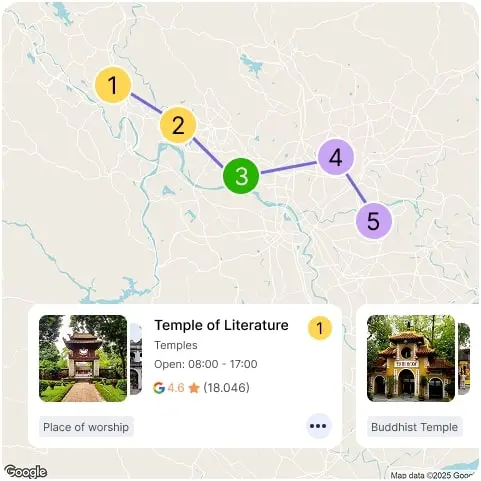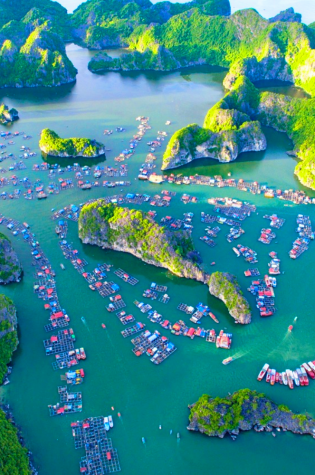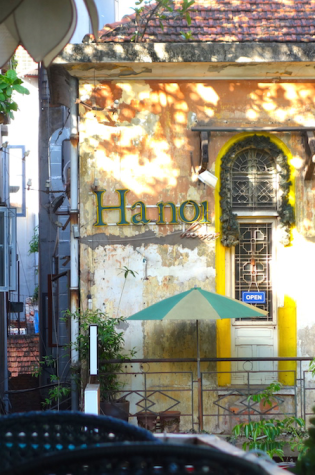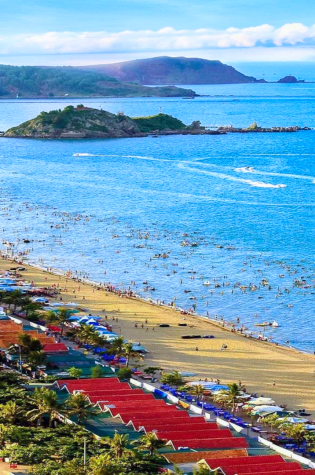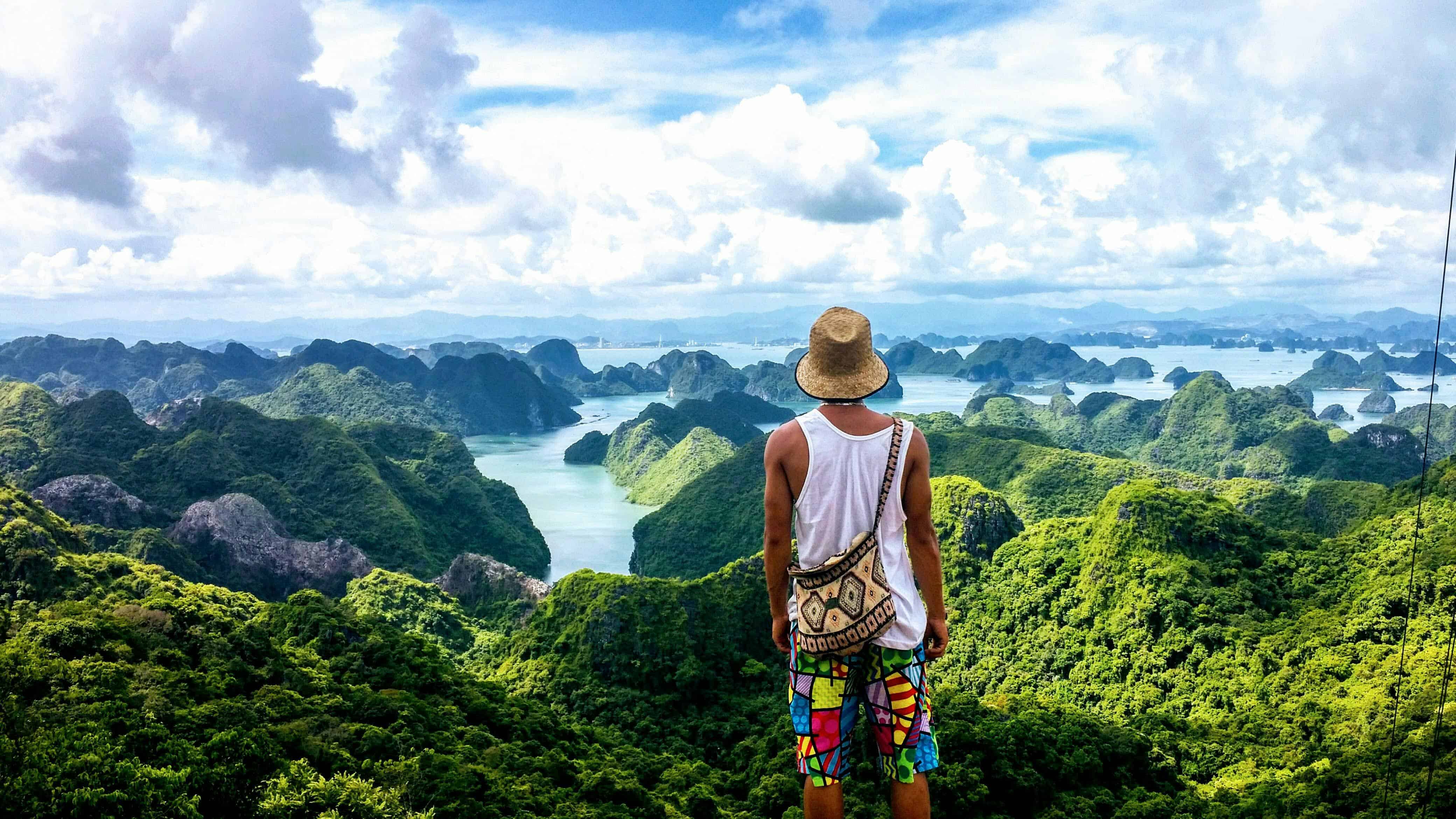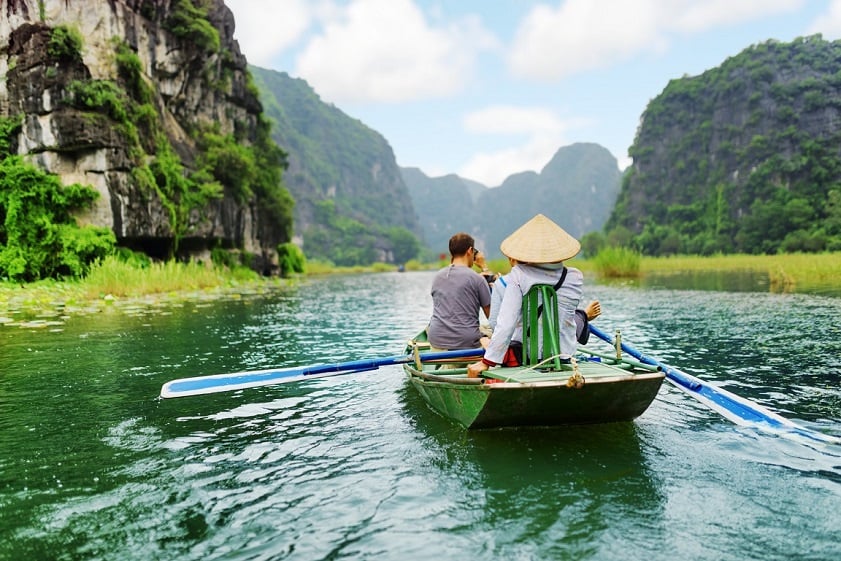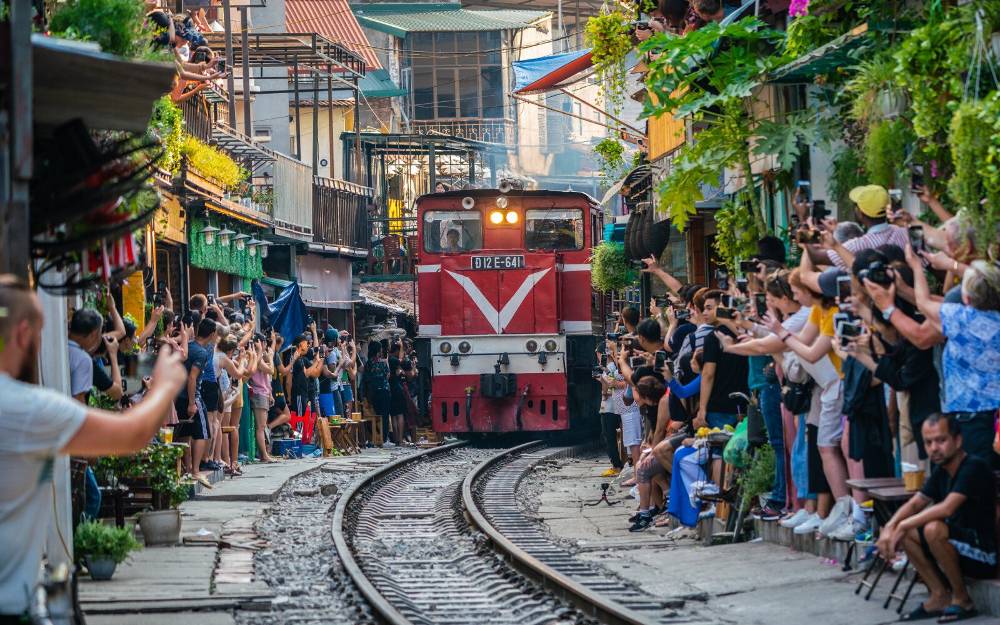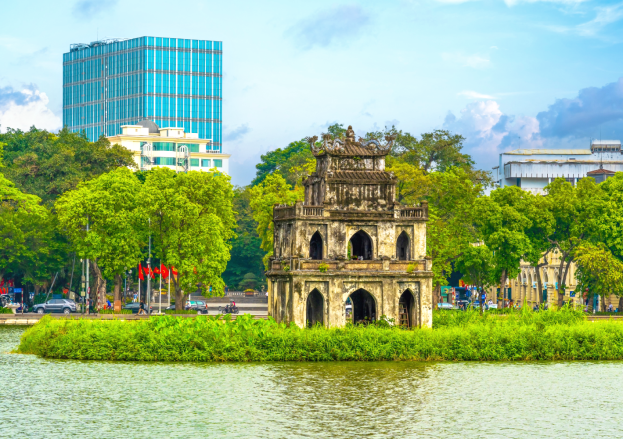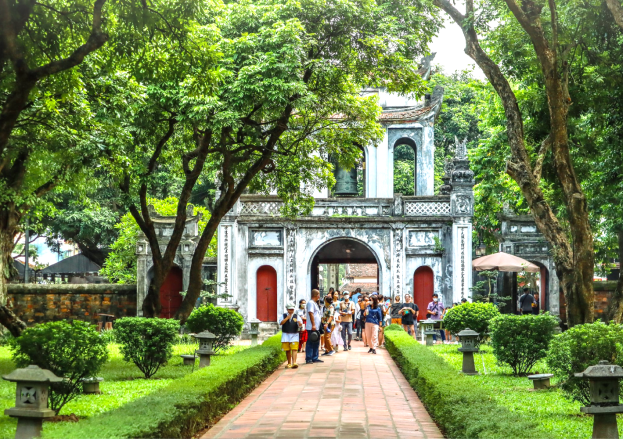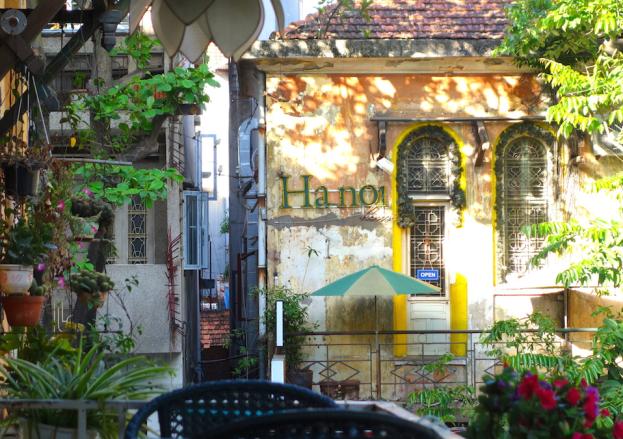
Eco Destinations
Step into Vietnam’s eco destinations, where every journey celebrates nature, supports communities, and creates lasting memories. Travel with care and leave a positive impact.
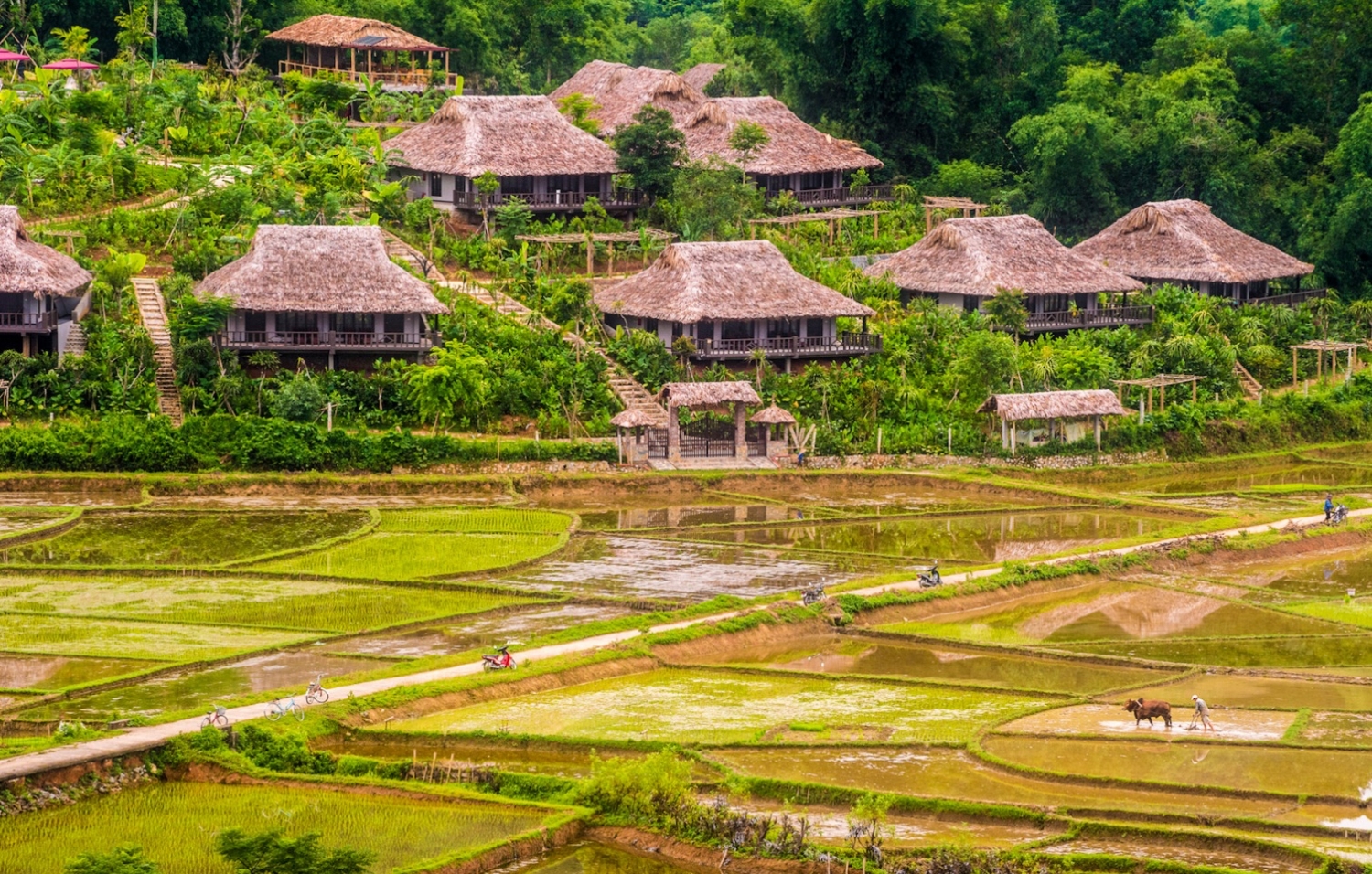
Experience life in Ban Lac on a journey to old Mai Chau
29 Aug, 2025
Ban Lac Community Tourism (Mai Chau) Ban Lac is a well-known community-based tourism site popular with both domestic and international visitors. Nestled in the Mai Chau valley of Hoa Binh Province, it is home to the Thai ethnic group and was historically called Muong Mun. The Thai people here live in concentrated, prosperous communities and have preserved their traditional culture, including stilt houses, culinary practices, and cultural expressions, which have shaped and developed tourism in the area. From Hanoi, travelers follow National Highway 6 toward Son La for about 130 km, then turn left at the Tong Dau intersection onto National Highway 15. After passing Mai Chau town for approximately 2.5 km, you will reach Ban Lac, which was named one of the 10 most interesting destinations in the world by Business Insider. Ban Lac, Mai Chau, Hoa Binh, is over 700 years old and consists of 129 households with 539 residents of various ethnic groups. Historically, locals relied on rice cultivation, upland farming, and brocade weaving. Over time, the hidden charm of Ban Lac was gradually discovered by tourists. Today, 74 households provide tourism services, offering meals and accommodations at family-run homestays. Each stilt house is numbered, elevated, clean, and preserves traditional architecture, with neatly arranged bedding inside. Locals continue traditional crafts, producing brocade textiles, handmade clothing, Thai skirts, wristbands, handbags, bows, crossbows, buffalo bells, and buffalo horns as souvenirs for visitors. At Ban Lac, beyond staying and dining in stilt houses, visitors can enjoy cultural experiences such as Xoe dancing, bamboo pole dancing, and drinking rice wine with local performance groups either at homes or at community bonfire areas. Tourists can also buy brocade textiles, handicrafts, taste traditional sticky rice cooked in bamboo, grilled dishes at households, and explore villages, caves, and local markets by electric cart, motorbike, or bicycle to discover the poetic and fascinating Ban Lac. Experiencing Ban Lac Ban Lac today is a well-established community tourism destination, familiar to travelers from near and far. It is not a bustling or grand place but offers a simple, natural, and welcoming environment. Visitors often remark that Ban Lac harmoniously blends tradition and modern culture, with locals providing tourism services without aggressively soliciting customers. Safety and order are ensured, and residents exhibit strong community spirit and unity. Mai Chau is home to seven ethnic groups, with the Thai people making up nearly 60%, followed by the Muong and Kinh over 11%, the Hmong at 9.6%, the Dao at 2.2%, and other ethnic minorities. Each group contributes unique cultural traits, providing favorable conditions for community-based tourism development. Other Community Tourism Spots Ban Pom Coong is another attractive destination, retaining the simple and peaceful charm of a highland rural area. Its name is unique: “Pom” in Thai means hill, and “Coong” means drum, so together it describes a village with hills resembling a drum. The landscape combines hills and fields, creating a stunning natural panorama. Ban Van is also appealing, quieter than Ban Lac, with neatly arranged stilt houses, spacious areas, and beautiful natural scenery. Visitors can enjoy the views, taste local cuisine, and learn about the traditional culture of the local people. For those wanting to explore further, Ban Hich in Mai Hich Commune, about 12 km from Mai Chau town center, offers peaceful village life, picturesque natural scenery that changes with the seasons, friendly locals, and cultural experiences such as traditional weaving, brocade, and basketry. Visitors can also taste local specialties like green-headed duck, wild vegetables, and fish, and explore the charming Xia stream by boat. Ban Buoc in Xam Khoe Commune, 25 km southwest of Mai Chau town, amazes visitors with its green landscapes. Travelers can relax while enjoying views of palm hills, winding terraced fields, and gentle smoke rising from stilt houses’ kitchens. Hmong Community Tourism Moving from Thai community tourism, visitors can explore Hmong community tourism. About 30 km from Mai Chau town along National Highway 6 toward Son La, Ban Cha Day in Pa Co Commune is situated at 1,140 meters above sea level. Residents primarily farm, raise livestock and poultry, and some run homestays. Visitors can experience a Saturday night market and the Pa Co Sunday market. A further 6 km leads to Ban Hang community tourism village, at nearly 1,000 meters above sea level, offering cool weather year-round. The Hmong people reside here, and in spring, visitors can see plum and peach blossoms covering the forests. Tourists can also admire sea-of-cloud views in the valley, learn about Hmong customs and traditions, try weaving and dyeing fabrics, make traditional clothing, and taste local specialties from the Northwest mountains such as sticky rice, village pork, grilled chicken, and sticky rice cakes.
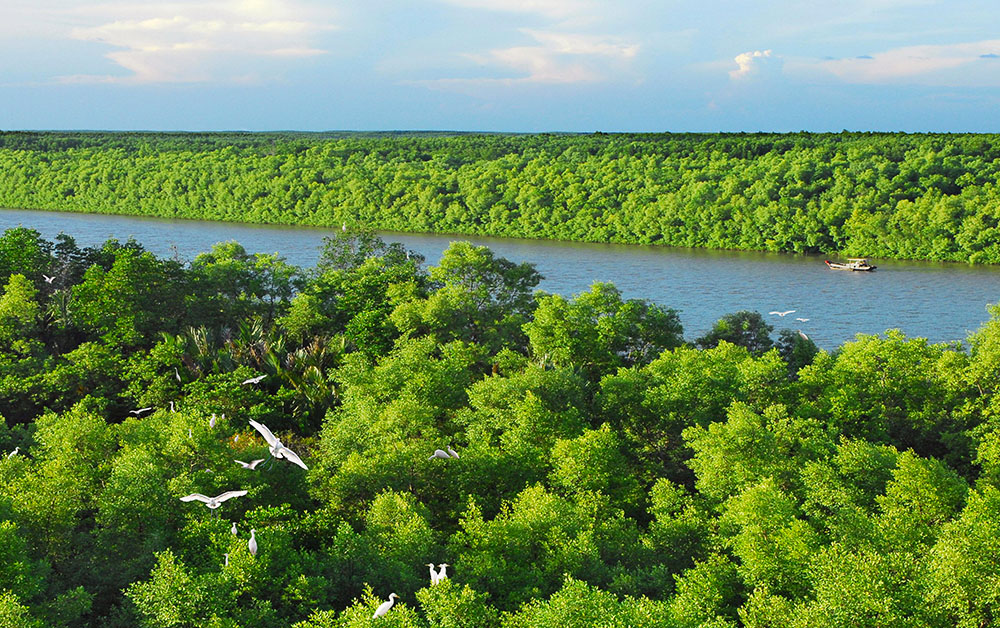
Visit Can Gio to experience Vietnam’s unique mangrove forest
29 Aug, 2025
The biodiversity values of Can Gio Mangrove Forest Can Gio Mangrove Forest is a sprawling, lush sanctuary located in its namesake district, in the Southeastern region of Ho Chi Minh City. This over 70,000-hectare-wide ecological gem not only protects the region from coastal erosion but also plays a critical role in preserving local biodiversity. Acting as a natural buffer against storms, the forest is a treasured biosphere reserve that invites both nature lovers and adventure seekers alike, all while playing the role of protector for the southern region from hurricanes, especially Ho Chi Minh City. Since it is recognized by UNESCO as Vietnam’s first biosphere reserve, Can Gio Mangrove Forest is a true haven for biodiversity. The forest’s lush vegetation includes 93 mangrove species as well as 225 introduced plants, making up 315 higher plant species. On the fauna side, this ecological gem supports an impressive range of creatures. From migratory birds that fly gracefully across the sky to the diversity of reptiles, crustaceans, and small mammals, the Can Gio Mangroves truly encapsulate nature’s diversity. The population here includes an impressive number of species: 89 insects, 282 fish, 36 amphibians, 36 reptiles, 164 birds, and 35 mammals. Must-see attractions in Can Gio Mangrove Forest Your time at Can Gio Mangrove Forest can be a trip back in time or a fun exploration of the flora and fauna here. It depends on which of these activities you decide to try out. Sac Forest War Base Exploring the Sac Forest War Base is like stepping into a hidden chapter of history right inside the Can Gio Mangrove Forest area. This intriguing site offers a fascinating glimpse into Vietnam’s war legacy interwoven with nature’s resilience. Visitors can wander through remnants of old bunkers and military relics, gaining insights from well-curated displays that recall the past. Vam Sat Tourist Area The enchanting realm of the Vam Sat Tourist Area is right in the heart of the Can Gio Mangrove Forest zone. Here, you will hop on a speed canoe and ride along serene waterways to uncover the secrets of local mangrove ecosystems like the Giant Bat Lagoon or the Tram Chim Reservation. Other than that, you can attempt to fish for crabs in an exciting competition or take in the scenery from the spectacular vantage point atop Tang Bong Tower. Monkey Island Monkey Island is one of the most unique and whimsical attractions in the Can Gio Mangrove Forest area. Once home to only a few monkey residents, the island is now bustling with over 2,000 playful and mischievous monkeys thanks to meticulous care in their habitat. Visitors can explore the island to learn about the fascinating behaviors and daily lives of these clever creatures or enjoy live shows on weekends and holidays starring the same cheeky residents of the island. Just be sure to secure your belongings, like your camera or phone, as they might just catch the attention of a handsy monkey. Dan Xay Mangrove Park Dan Xay Mangrove Park is an immersive eco-adventure destination where learning and fun seamlessly intertwine. Visitors can get their hands dirty with activities right in the mangrove ecosystem, whether it is tree-planting activities, discovering innovative aquaculture techniques, or delving into the daily life of local forest guardians. If you want to get moving, there are memorable journeys by canoe, kayak, or even electric car tours through the lush forest trails. The park also offers unique opportunities like camping under the stars and trying your hand at catching local seafood, so there will never be a dull moment. Craft villages As you really venture into the mangrove forest of Can Gio, you will come across various craft villages. In Tam Thon Hiep, the once-bustling mat-weaving village still quietly continues their tradition, with less than 10 households keeping the meticulous craft alive. Meanwhile, down by the water at Can Thanh, Long Hoa, and Thanh An, fishing hamlets are a key part of the vivid coastal life. Watching fishermen haul in their fresh catch at dawn or dusk feels like a scene from a postcard; only now, you can capture the photos yourself. Speaking of spectacular sights, the salt village Tan Dien Hamlet, Ly Nhon, is especially magical in the dry season. As you feast your eyes on the scenery, you can learn a thing or two about a time-honored trade whose products now reach as far as the EU. Lastly, you will catch sight of a vital community of forest keepers in Tam Thon Hiep, An Thoi Dong, and Ly Nhon, where generations have lived by planting, protecting, and preserving the precious mangrove environment. Sacred sites Each area in Ho Chi Minh City has something that lets visitors get a glimpse into the colorful history of the city, and Can Gio Mangrove Forest is no exception. Make your way to these spots in the area to uncover some amazing stories: Can Thanh Temple is a cultural beacon in Can Gio with its distinctive wooden architecture and a serene space for community gatherings, playing an indispensable role in preserving local traditions in Ho Chi Minh City. Duong Van Hanh Temple is a revered sacred site characterized by traditional Vietnamese architecture. Its rich history and spiritual legacy of “The Headless Deity” are worshiped in a peaceful setting. Thuy Tuong Can Thanh Mausoleum, established as a tribute to the revered water marshal, features an awe-inspiring 12-meter-long whale skeleton that magnificently embodies the cultural pride and historical heritage of Can Gio. Best time to visit Mangrove Forest in Can Gio When it comes to planning your Can Gio Mangrove Forest, Vietnam, adventure, timing is everything. The dry season, typically from December to April, is best for a trip here, so you can enjoy the outdoor activities to the fullest. In addition to favorable weather, Can Gio comes alive with vibrant festivals throughout the year, so you might want to plan around those occasions. For example, the Nghinh Ong Festival in the 8th lunar month is an event featuring traditional rituals and more. The Can Gio Mangrove Forest is more than just a green lung of Ho Chi Minh City—it is a living treasure that harmoniously blends biodiversity, history, and culture. From lush mangrove ecosystems and playful monkeys to sacred temples and traditional craft villages, every corner of this biosphere reserve offers something unique. A visit here is not only an eco-adventure but also a journey into Vietnam’s natural and cultural heritage. Whether you are a nature enthusiast, a history lover, or simply someone seeking a peaceful escape from the bustling city, Can Gio Mangrove Forest promises an unforgettable experience.
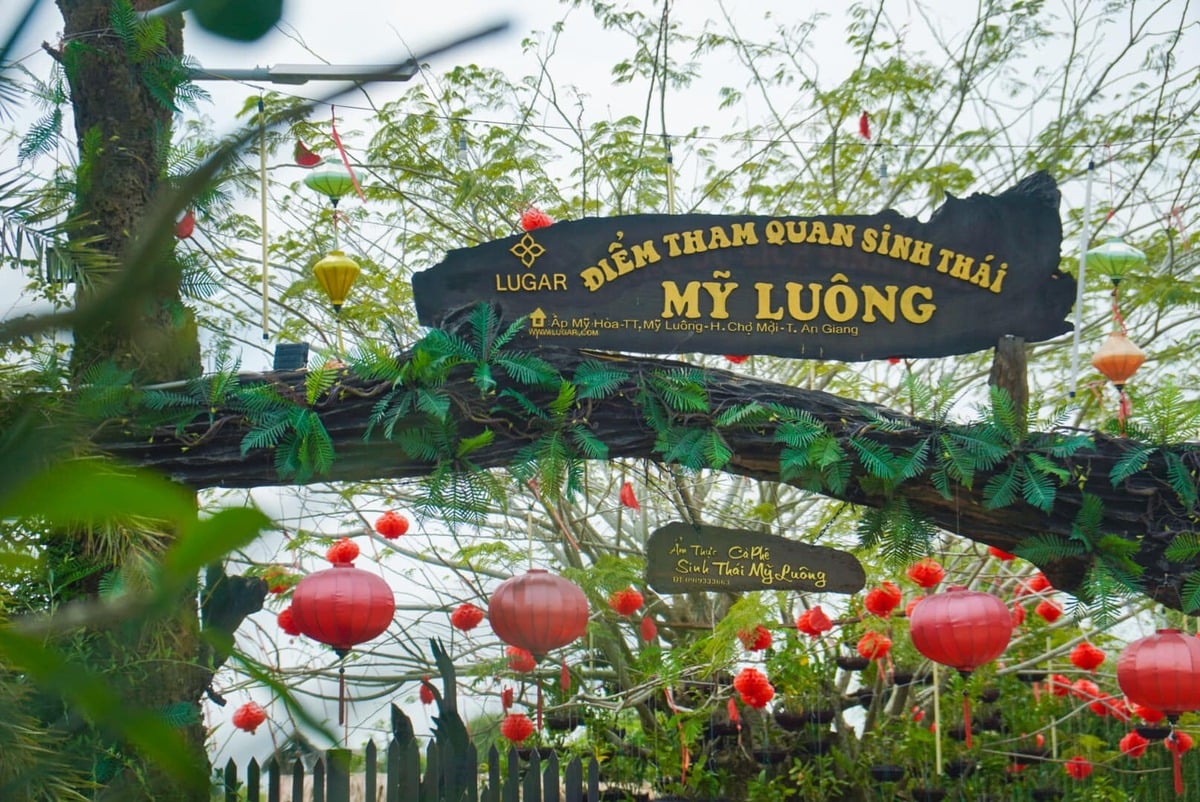
Immerse yourself in the natural wonders of My Luong
29 Aug, 2025
Explore Scenic Landscapes One of the first things that immediately captivates visitors to My Luong is its breathtaking and ever-changing natural scenery. The region is crisscrossed by winding rivers that glisten under the sunlight, their banks lined with dense bamboo groves swaying gently in the breeze. Serene lakes, like mirrors, reflect the sky and surrounding greenery, creating a sense of perfect harmony between water and land. The rolling rice fields stretch as far as the eye can see, their colors shifting with the seasons—from vivid emerald green in the early growing season to rich golden hues just before harvest. Towering limestone hills punctuate the horizon, their rugged silhouettes adding drama to the otherwise gentle landscape. As the sun rises and sets, the play of light and shadow across the hills, rivers, and paddies transforms the scenery into a living painting, captivating photographers, artists, and travelers alike. Walking or cycling through the area, you can feel the subtle rhythm of rural life intertwined with nature. Early mornings bring a mystical atmosphere, with mist hovering over the rice paddies and the soft murmur of streams weaving through the fields. Birds sing in the bamboo groves, their calls echoing across the valleys, while dragonflies skim the water’s surface, adding delicate motion to the serene scene. Along narrow earthen paths, locals can be seen tending to their crops, gently guiding water through irrigation channels or carrying bundles of freshly cut rice—a glimpse into centuries-old agricultural traditions. This immersive experience allows visitors to slow down, breathe deeply, and truly absorb the tranquility and harmony of My Luong’s natural landscapes. Whether you choose to wander along riversides, pause beside reflective lakes, or climb gentle hills to admire panoramic vistas, every step offers new perspectives and unforgettable views. The combination of water, rice fields, forests, and limestone formations creates a visual symphony that embodies the essence of rural Vietnam, leaving visitors with a profound sense of peace and wonder. Discover Local Villages and Traditions Beyond the landscapes, My Luong is a living museum of Vietnamese culture. The small villages that dot the region invite travelers to experience traditional crafts and local ways of life. You can: Visit rice paddies and watch farmers work with traditional methods that have been passed down for generations. Participate in craft workshops, such as pottery, weaving, or bamboo crafting, learning the hands-on skills that sustain local communities. Sample fresh, home-cooked meals made from ingredients grown in the surrounding fields and gardens. Interacting with villagers provides not only a cultural experience but also insight into the delicate balance between human life and the natural environment, which has shaped My Luong for centuries. Adventure on Water and Land For those seeking adventure and exploration, My Luong offers a variety of activities to suit every type of traveler: Kayaking and Boat Tours Glide along peaceful rivers and hidden waterways in a kayak or small boat, allowing you to explore the secret corners of My Luong that are often unreachable by foot. Drift under overhanging bamboo groves and past lotus-filled lakes while observing herons, kingfishers, and other waterbirds in their natural habitat. The gentle movement of the boat invites moments of calm reflection as you listen to the soft ripple of water and the whisper of the wind through trees. Some tours even venture into freshwater streams that feed into the lakes, revealing small waterfalls, rock formations, and quiet coves perfect for photography or a short picnic. Hiking and Trekking For those who love land-based adventures, hiking and trekking through My Luong’s forested trails and limestone hills offer a blend of physical challenge and natural beauty. Each path leads to a unique vantage point—whether it’s a waterfall cascading over moss-covered rocks, a panoramic overlook of terraced rice fields, or limestone cliffs that frame the horizon. Along the way, travelers encounter dense vegetation, wildflowers, and the occasional sighting of wildlife such as small birds, butterflies, or monkeys. The trails vary from gentle slopes suitable for casual walkers to more rugged climbs for those seeking a sense of achievement and exhilaration. Cycling Adventures Cycling through My Luong is another popular way to immerse yourself in the countryside. Quiet roads and narrow dirt paths connect villages, rivers, and natural landmarks, providing an eco-friendly way to explore at your own pace. Pedal past fields of rippling rice, cross small wooden bridges, and wave to local farmers tending their crops. Cycling allows visitors to cover more ground than hiking while still feeling intimately connected to the environment. Along the way, you can stop to observe traditional farming practices, enjoy local snacks, or photograph scenic vistas that stretch as far as the eye can see. Wildlife and Biodiversity My Luong is home to a rich variety of flora and fauna. The area’s wetlands, forests, and cultivated lands create habitats for countless species: Birdwatchers can spot kingfishers, herons, and other native birds. Botanists and plant enthusiasts will enjoy discovering rare herbs, aquatic plants, and forest trees that thrive in the region. Small mammals, reptiles, and amphibians inhabit the forests and wetlands, while freshwater fish populate the rivers and streams. This biodiversity makes My Luong an ideal destination for eco-tourists, nature photographers, and anyone interested in learning about Vietnam’s natural heritage. Sustainable Travel Tips To fully enjoy your visit while protecting My Luong’s delicate ecosystem, keep in mind a few practical tips: Wear comfortable shoes and clothing suitable for hiking, boating, and cycling. Bring sunscreen, hats, and insect repellent for sun and insect protection. Respect local customs and the natural environment—avoid littering, picking plants, or disturbing wildlife. Support local communities by purchasing handmade crafts or tasting locally grown foods. Visiting My Luong Eco Tourism Area is more than just a sightseeing trip—it is an immersive journey into the heart of Vietnam’s natural and cultural landscapes. From paddling along tranquil rivers to trekking through vibrant forests, from observing rare wildlife to engaging with welcoming villagers, every moment offers unique experiences that create lasting memories. Whether you are seeking adventure, serenity, or cultural connection, My Luong promises a rare blend of discovery and relaxation. This hidden treasure invites you to slow down, explore deeply, and immerse yourself in the natural wonders that make Vietnam so extraordinary.
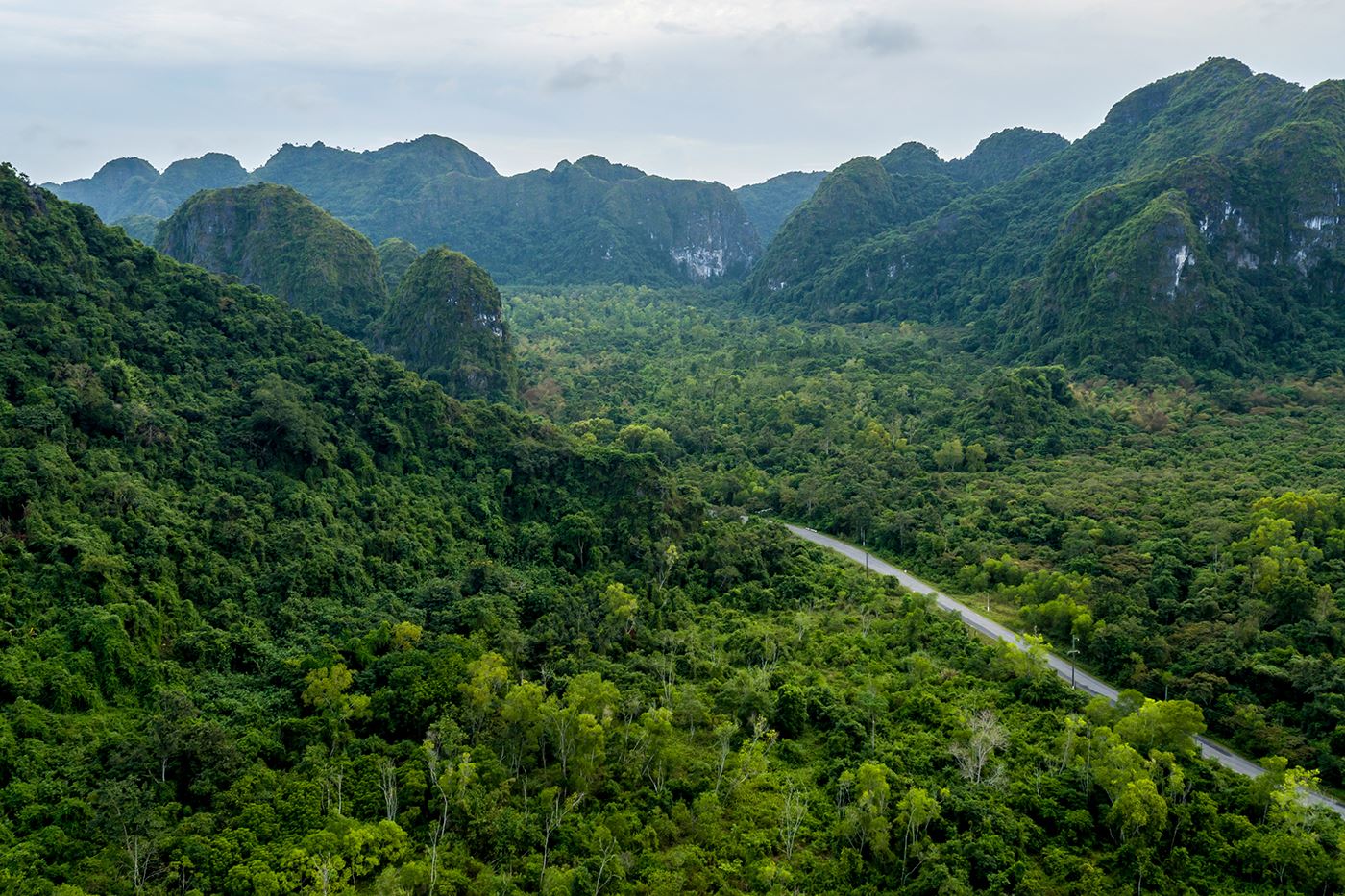
Discover Cat Ba National Park – the green lung thriving amidst the sea
29 Aug, 2025
Cat Ba National Park – The “Green Lung” of Hai Phong Cat Ba National Park is located along the Cat Ba Island Road, Tran Chau Town, Cat Hai District, Hai Phong City, about 30 km south of the city center. It is one of the largest special-use forests in Vietnam and a UNESCO-recognized biosphere reserve. The park preserves a wide range of ecosystems, including marine environments, terrestrial forests, mangroves, and numerous rare species of flora and fauna. The park covers a total natural area of 17,360 hectares, including 11,000 hectares of forest and 6,500 hectares of marine waters. Thanks to favorable climate and environmental conditions, Cat Ba National Park has become an ideal location for the development and preservation of diverse ecosystems. Currently, the park’s ecosystems include over 282 plant species and nearly 800 animal species living both on land and in the sea. In addition to its rich biodiversity, Cat Ba National Park also attracts numerous domestic and international tourists due to its historical value. Archaeological evidence shows that humans have inhabited this area for thousands of years. What Can You Explore in Cat Ba National Park? Forest Ecosystem The forest ecosystem in Cat Ba National Park is a true treasure trove of biodiversity, hosting thousands of plant and animal species. Walking through the park, visitors can marvel at towering ancient trees with massive trunks and expansive canopies that create shaded, cool pathways. The forests are divided into three main types: Primary Forest: This pristine forest area features old-growth trees, rare orchids, ferns, and a variety of shrubs. The untouched environment provides habitats for numerous birds, small mammals, and insects, making it perfect for nature lovers and photographers. Mangrove Forest: Found near the coastline and estuaries, mangrove forests are essential for maintaining the ecological balance. They act as nurseries for young fish and crustaceans and provide shelter for migratory birds. Walking along the wooden boardwalks through the mangroves allows visitors to experience the unique water-forest interface. Conifer Forest: A rare ecosystem unique to Cat Ba Island, this forest type includes the island’s endemic conifers. These trees stand tall with needle-like leaves and provide a distinct contrast to the surrounding tropical greenery, offering a serene and almost mystical environment for trekkers. Exploring the forest areas, visitors can hear the calls of wild birds, spot squirrels and other small mammals, and even glimpse the occasional langur swinging through the treetops. The forest is a perfect blend of serenity and adventure. Marine Ecosystem The park’s marine ecosystem stretches across bays, coastlines, and limestone foothills, boasting nearly 1,500 species of marine life. Snorkelers and divers are treated to vibrant coral reefs teeming with colorful fish, starfish, sea urchins, and a variety of algae. Seaweed and plankton thrive here, supporting a rich underwater food web. Visitors can actively engage with this ecosystem through several activities: Kayaking: Paddle along calm waters between limestone islands, discovering hidden caves, secluded beaches, and mangrove inlets. Snorkeling and Diving: Observe colorful corals and tropical fish up close in crystal-clear waters. Beach Activities: Relax on pristine beaches, swim in calm bays, or explore tidal pools filled with fascinating marine life. The combination of tranquil waters, limestone cliffs, and thriving marine habitats makes this area a paradise for nature enthusiasts and water sports lovers alike. Rare Wildlife Although less extensive than the forest and marine ecosystems, the park’s wildlife is no less remarkable. Cat Ba National Park is home to approximately 1,000 fish species, 60 mammals, nearly 200 bird species, 50 reptiles, and 20 amphibians. The island’s most famous resident is the Cat Ba langur (golden-headed langur), a critically endangered primate found only here. Visitors may catch glimpses of these rare langurs leaping between cliffs and ancient trees—a truly unforgettable sight. Other notable animals include monitor lizards, various snake species, otters, and a wide variety of birdlife, including kingfishers, herons, and egrets. The park also hosts amphibians such as frogs and toads, which play an essential role in maintaining ecological balance. With such rich biodiversity and diverse habitats, Cat Ba National Park offers an immersive experience for anyone passionate about exploring and studying natural flora and fauna. Each ecosystem—from lush forests to vibrant coral reefs—invites visitors to witness the island’s remarkable natural heritage firsthand. Tips for Visiting Cat Ba National Park As a UNESCO biosphere reserve, visitors should follow these guidelines: Do not litter; maintain cleanliness. Do not cut trees, pick flowers, or damage plants. Be environmentally friendly and avoid disturbing wildlife. Bring sufficient snacks and drinks for a comfortable exploration. Prepare necessary medications such as cold medicine, headache relief, fever reducers, and mosquito repellent. Cat Ba National Park is more than just a natural reserve—it is a living laboratory of biodiversity and a haven for eco-adventures. From exploring dense forests and mangroves to discovering rare wildlife and diving into crystal-clear waters, every visit promises unique experiences. By respecting the park’s environment and following sustainable practices, travelers can help protect this irreplaceable treasure for generations to come
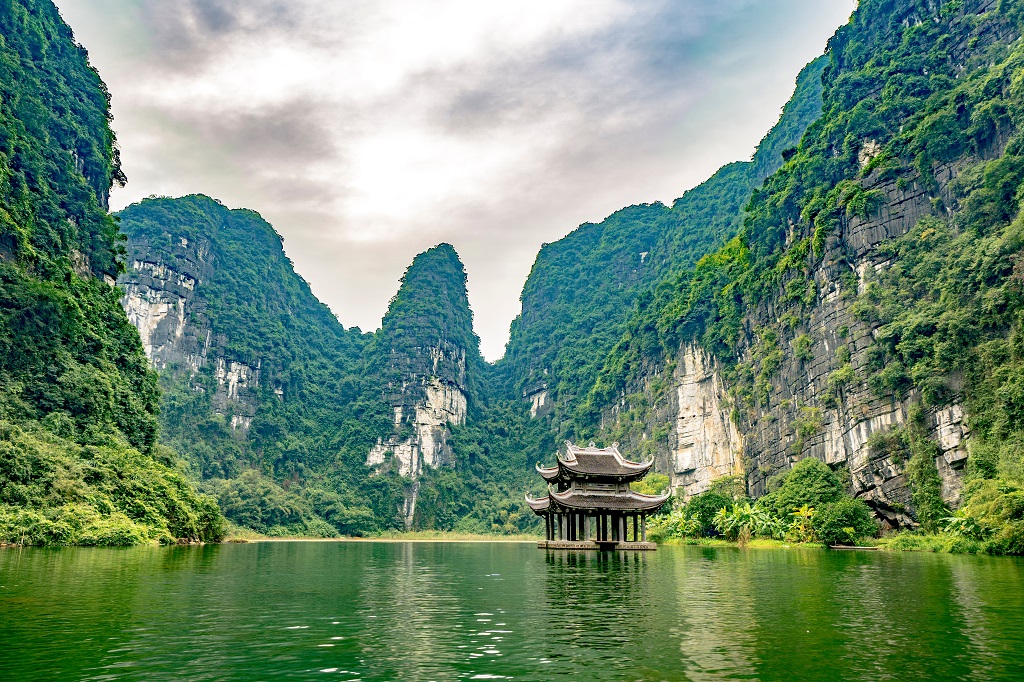
Journey through the World Cultural and Natural Heritage of Trang An
29 Aug, 2025
Unique mixed heritage The Trang An Scenic Complex covers an area of 12,252 hectares, including three conservation zones: the Hoa Lu Ancient Capital Historical and Cultural Site, the Trang An – Tam Coc – Bich Dong Scenic Area, and the Hoa Lu Special-Use Primary Forest, with a buffer zone of 6,026 hectares. In 2014, the Trang An Scenic Complex became the first and only mixed heritage site in Southeast Asia recognized by UNESCO as a World Cultural and Natural Heritage site. It met Criterion V for cultural significance and Criteria VII and VIII for natural beauty and geological formations. Within the Trang An Scenic Complex, Trang An Ecotourism Area is famous for its characteristic karst limestone landscape, along with a rich ecosystem of forests, caves, and wetlands. Formed over hundreds of millions of years through geological changes, climate shifts, and the rise and fall of sea levels, Trang An boasts 31 interconnected lakes and 48 caves. This cave system makes the ecotourism area unique, offering boat tours along routes where visitors do not need to backtrack, unlike in many other locations. Trang An also features diverse aquatic ecosystems, home to numerous rare species of flora and fauna, including thousands of types of algae and moss, which scientists describe as an “underwater primary forest.” The harmony between natural scenery and biodiversity creates a truly spectacular environment. Alongside its natural formation history, Trang An is also known as the “cradle” of prehistoric human evolution. Archaeological excavations suggest that prehistoric communities settled in the caves and rock shelters at the core of Trang An tens of thousands of years ago. These people were among the first in Vietnam to access and exploit the sea, creating limestone tool complexes, developing flaking techniques, crafting pottery, and practicing agriculture in the wetland valleys. These features contribute to the global cultural significance of the heritage site. Additionally, Trang An is associated with historic sites such as Hoa Lu Ancient Capital, Bai Dinh Pagoda, Tran Temple, Phu Khong, Vu Lam Palace, and Cao Son Temple, offering visitors a variety of fascinating tour options. Attractions in Trang An ecotourism area Trang An Ecotourism Area is not only renowned for its picturesque river and mountain landscapes but also for its unique cultural, historical, and natural values. Here are the must-visit attractions in Trang An: Cultural and Spiritual Sites Trang An is a land rich in cultural heritage, preserving many historically significant spiritual sites: Trinh Temple: This temple honors four prominent mandarins of the Dinh Dynasty who helped King Dinh Tien Hoang consolidate power and lay the foundation for the Dai Co Viet state. Its ancient architecture set against the scenic mountains creates a solemn and tranquil atmosphere. Tran Temple (Ninh Binh): Established by King Dinh Tien Hoang to worship the deity Quy Minh, guardian of the southern gate of the Hoa Lu Four Protectors. The temple combines traditional Vietnamese architecture with its natural surroundings, creating a distinctive cultural highlight in Trang An. Tu Tru Temple: Dedicated to four high-ranking mandarins of the Dinh Dynasty who helped quell the 12 warlords and establish the Dai Co Viet state. This site is important for understanding the history and culture of the Dinh period. Phu Khong: A site venerating seven loyal officials of the Dinh Dynasty, reflecting the respect and reverence of the people for these historical figures. Vu Lam Palace: A structure preserving traces of the royal court, reflecting the political and cultural life of the Dinh and Le dynasties, harmoniously integrated with the surrounding natural scenery. Mysterious Caves Trang An is also famous for its impressive limestone cave system, each with its own story and significance: Dia Linh Cave: Nearly 1,500 meters long, featuring unique stalactites and fossilized stalagmites. The interior creates a mysterious atmosphere, ideal for those who love exploring majestic natural formations. Nau Ruou Cave: Notable for its underground spring over 10 meters deep, where hundreds of traditional wine jars have been distilled from this pure water source. This cave also represents the long-standing traditional crafts of local people. Boi Cave: Revealing traces of prehistoric humans from around 10,000 years ago, this cave holds significant archaeological value and attracts researchers and visitors interested in ancient history. Sang – Toi Cave and Ba Giot Cave: These caves are also worth exploring, featuring unique stalactites, stalagmites, and striking natural scenery. Each cave offers a different experience, from the cool interior to the scenic views outside. The Trang An Scenic Complex is not only a breathtaking natural wonder but also a living museum of Vietnam’s history and culture. With its harmonious blend of majestic limestone landscapes, diverse ecosystems, ancient spiritual sites, and archaeological treasures, Trang An offers visitors a journey through both time and nature. Recognized by UNESCO as Southeast Asia’s first mixed heritage site, it stands as a symbol of the deep connection between humans and the environment. A visit to Trang An is more than just sightseeing – it is an unforgettable experience of discovering the roots of civilization and the timeless beauty of Vietnam.
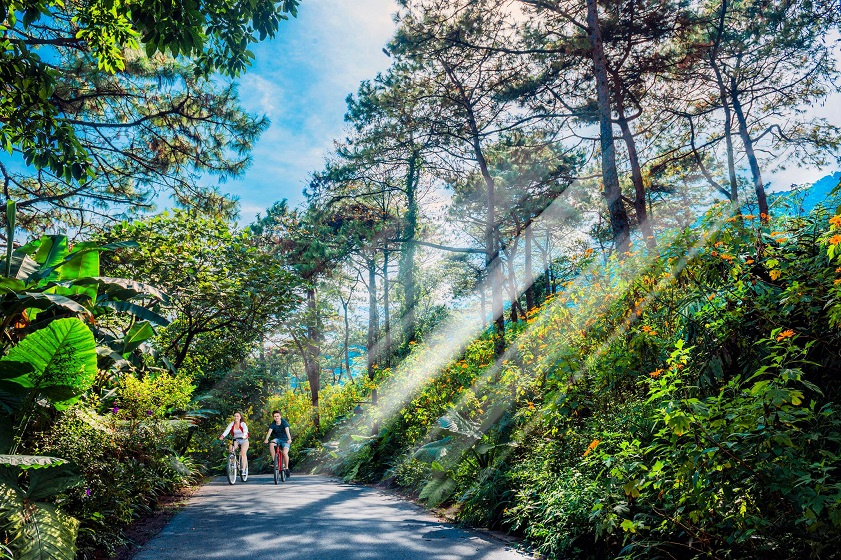
Explore breathtaking views on a Ba Vi National Park Trek
29 Aug, 2025
Ba Vi National Park is located in the Ba Vi Mountain Range, which lies within the Hanoi administrative region. The park spans over 10,000 hectares, covering a large portion of the Ba Vi district, which is part of Hanoi’s western outskirts. The park is named after Ba Vi, the mountain range that dominates the area, consisting of three main peaks: King Peak (1,296 meters), Silver Peak (1,226 meters), and Vua Peak (1,131 meters). Ba Vi offers visitors a chance to escape urban life and connect with nature. These peaks, rising dramatically above the surrounding landscape, form a breathtaking backdrop that is visible from various parts of Hanoi. The park itself is recognized for its diverse ecosystems, which include lush tropical forests, pristine streams, and rocky outcrops. It is an area of exceptional natural beauty that combines rich biodiversity with historical significance. Ba Vi is also home to several different climatic zones due to its elevation, ranging from subtropical at the base to temperate near the summit. This variety of climates makes the park an ideal habitat for a wide range of plant and animal species. Top 10+ Must-see Attractions in Ba Vi National Park The Deep Woodland The deep woodland in Ba Vi National Park is characterized by its rich biodiversity and dense forest cover. Located mainly at mid and high elevations, these forests are a blend of tropical and temperate ecosystems, due to Ba Vi's unique topography and climate. The woodlands are a mixture of evergreen trees, ferns, shrubs, and flowering plants, creating a dense and thriving environment that is home to various animal species. The Green Pine Forest The Ba Vi Pine Forest is one of the park’s most scenic spots. The tall pine trees and cool, fresh air create a peaceful environment perfect for a leisurely walk. The forest is home to a variety of wildlife, and you may even spot some deer or wild boar while exploring. Cactus Greenhouse The Cactus Greenhouse is a specially designed space that simulates the dry, arid conditions required for cacti and other desert plants to thrive. The greenhouse is maintained by the park authorities and serves as both a botanical exhibit and an educational space for visitors to learn about the diverse species of cacti and succulents from around the world. The greenhouse typically contains a variety of cacti species, from small decorative ones to larger, more towering varieties. It also houses other types of succulent plants that are adapted to survive in harsh, dry environments. These plants are usually native to arid regions such as deserts in Africa, the Americas, and the Middle East. The Ancient Church Near the French villas, you’ll find the ruins of an old French Church, built during the colonial era. Although the church is in a state of decay, its historical significance and the atmosphere surrounding the ruins make it a popular stop for visitors. It’s another reminder of Ba Vi’s colonial past, offering a unique perspective on the history of the area. Uncle Ho's Temple Uncle Ho's Temple (also known as Ho Chi Minh Temple) is a significant cultural and historical site dedicated to Ho Chi Minh, the beloved leader of Vietnam. This temple stands as a testament to the deep respect and admiration the Vietnamese people have for Uncle Ho, who played a pivotal role in the country's struggle for independence and reunification. Upper Temple (Den Thuong) The Upper Temple offers not only a deep cultural and spiritual experience but also some of the most stunning panoramic views of the surrounding landscapes. Visiting this temple is an essential part of the Ba Vi experience, as it beautifully combines history, nature, and spirituality. The architecture of “Den Thuong” is traditional Vietnamese, with elements reflecting the local culture and the region’s spiritual heritage. Bao Thien Tower Bao Thien Tower is one of the iconic landmarks of Ba Vi National Park, standing tall on King Peak (Vua Peak) at an elevation of 1,296 meters. It is a symbol of the park’s rich history and offers visitors not only a cultural insight but also breathtaking views of the surrounding landscape. Over the centuries, the tower has gone through several renovations and reconstructions. Though much of the original structure has been lost to time, the current Bao Thien Tower still stands as a testament to Vietnam’s historical architecture and religious heritage. Ngoc Hoa Stream Ngoc Hoa Stream is located in the heart of Ba Vi National Park, a sprawling natural reserve just outside of Hanoi. The stream is nestled among the dense woodlands of Ba Vi, which is famous for its biodiversity and towering mountains. It flows through a relatively untouched area of the park, making it a popular destination for nature lovers, photographers, and anyone seeking tranquility. Thien Son Suoi Nga Thien Son Waterfall is a beautiful natural feature located in the southern part of Ba Vi National Park. The waterfall cascades through the lush forest, creating a tranquil atmosphere. It’s a short hike from the parking area, making it a great destination for those looking for a peaceful nature experience. Ruins of Political Prison Located within the park’s lush forests and dramatic mountain scenery, these ruins stand as a reminder of the dark chapter in the country’s history, particularly during the French colonial period and the Vietnam War. The site once housed political prisoners who were detained by the French colonial administration, and later by the Vietnamese government during the war. Today, it serves not only as a historical site but also as a symbol of the resilience and endurance of the Vietnamese people. The site was used by the French colonial government to imprison political dissidents, revolutionaries, and nationalists who opposed their rule. The prison was built on the rugged, secluded hills of Ba Vi Mountain to keep prisoners isolated and away from any outside influence. 600 Blockhouses These blockhouses are most famously linked to their role during the Vietnam War, when they were used as part of the defense against American military forces. The 600 Blockhouses were spread throughout the Ba Vi region and served both as shelters for the Vietnamese soldiers and as lookout points to monitor enemy movements. The region, with its rugged terrain and dense forests, provided the perfect camouflage and fortification for these structures. Ways To Get To Ba Vi National Park from Hanoi By Private Vehicle Driving to Ba Vi National Park is the most convenient and flexible option, especially if you’re traveling with family or friends. The journey takes approximately 1.5 to 2 hours, depending on traffic, and offers a comfortable ride through scenic countryside. From Hanoi, particularly from central areas like Ba Dinh District Hanoi, visitors take the Thang Long Boulevard (National Road 32) heading west then follow the signs to Ba Vi District. When you reach the Ba Vi district, turn towards the park entrance. You’ll be able to follow the signs leading directly to Ba Vi National Park. By Taxi If you're looking for a direct, private, and convenient mode of transportation, a taxi or ride-hailing service can be a good option. It’s more expensive than taking the bus or public transportation, but it offers door-to-door service and the comfort of a private vehicle. By Bus There are regular buses from Hanoi to Ba Vi, and this is a budget-friendly option for those who prefer not to drive. You can get the bus route 20B, route 71, route 74, route 77. The bus journey takes around 1.5 to 2 hours. Travel Tips for Ba Vi National Park Here are some useful tips for traveling in ecological areas like Ba Vi, Pu Luong, or other nature destinations: Wear suitable clothing: Choose comfortable, weather-appropriate clothes and sturdy shoes for walking on uneven terrain. Bring essentials: Carry water, snacks, insect repellent, a hat, and a small trash bag to keep the area clean. Respect nature and culture: Avoid damaging plants or disturbing wildlife and interact politely with local communities. Visit at the right season: Travel during the dry season for trekking and the rice harvest or blooming periods for the best scenery. Choose proper transportation: Motorbikes, self-driving cars, taxis, or buses are all options; stay cautious on winding mountain roads. Select suitable accommodation: Stay in homestays for cultural immersion or resorts/bungalows for comfort near nature. Use a map or navigation app: Helps you find trails, attractions, and avoid risky areas. Prioritize safety: Never trek alone in deep forests or difficult paths and inform hosts or park staff about your plans. Ba Vi National Park is more than just a scenic escape—it’s a journey into Vietnam’s natural beauty, history, and culture. From trekking through lush forests and exploring waterfalls to visiting historical sites and temples, every corner offers a unique experience. Whether seeking adventure, relaxation, or a deeper connection with nature, Ba Vi promises unforgettable memories and a peaceful retreat from the city’s hustle.
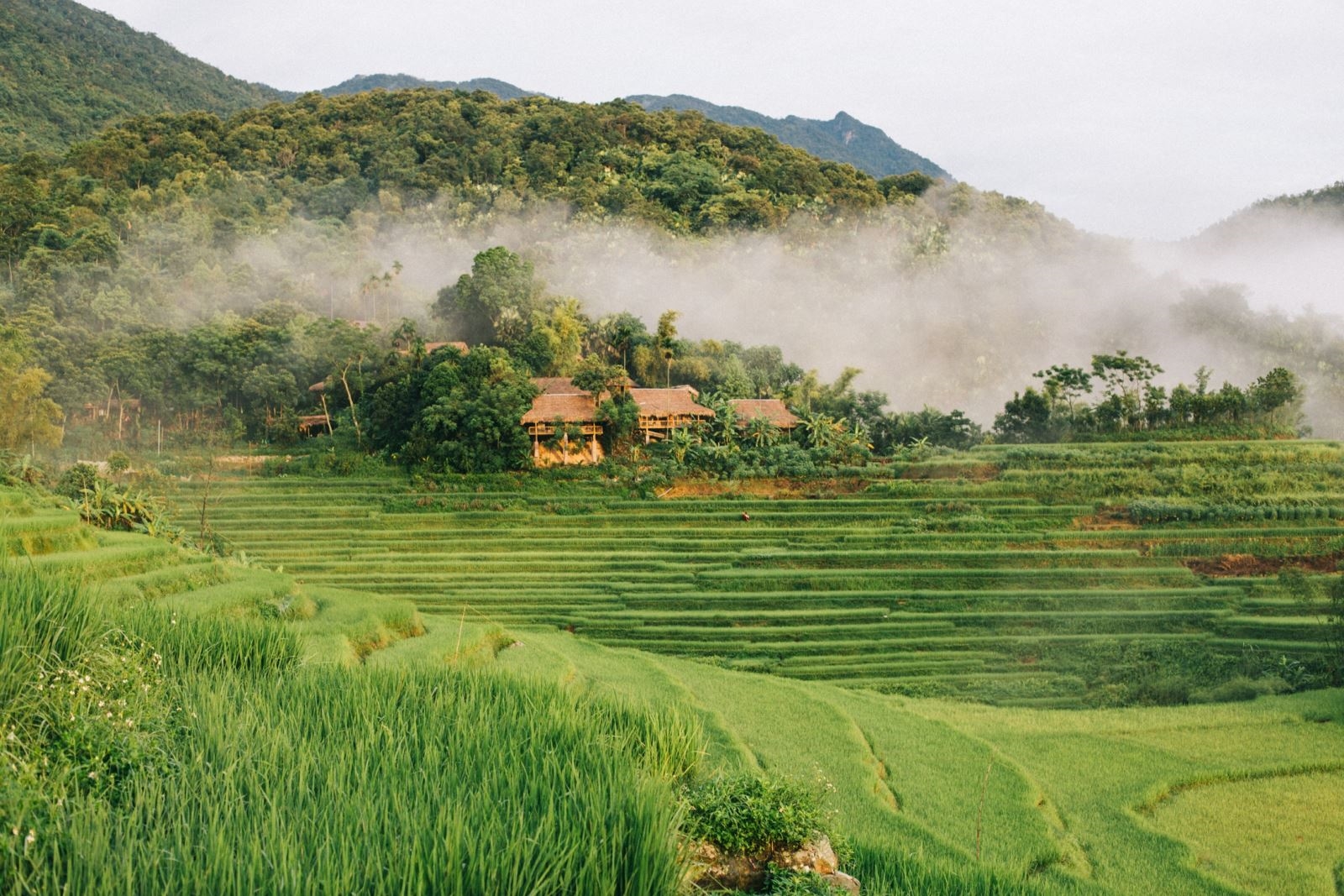
Pu Luong nature retreat: A journey into eco-friendly exploration and local culture
29 Aug, 2025
The beauty of Pu Luong captivates with its rare untouched nature. It is home to many rare species of flora and fauna, particularly the white-cheeked langur—a distinctive symbol of the region. Beyond its natural charm, Pu Luong preserves the traditional culture of the Thai and Muong people, from rustic stilt houses to intricate handicrafts. Visitors can experience trekking through Pu Luong’s forests, peaceful boat rides on the Cham Stream, or explore fascinating cave systems. Walking through Thai villages and participating in local festivals also offers unforgettable moments. For those planning a trip to Pu Luong, the best time to visit is around May to June or September to October, when the terraced fields turn golden, creating a picturesque landscape. Pu Luong not only offers an escape from the hectic pace of life but also opens up a peaceful, close-to-nature, and poetic world amid the mountains. Best Time to Visit Pu Luong According to many travel enthusiasts, the dry season from April to October is the ideal time to visit Pu Luong. The stable weather and minimal rainfall make it perfect for trekking, exploring villages, and eco-tourism. In particular, two periods are highly recommended: Late May to early June: The rice fields turn golden, forming a vibrant countryside scene full of color. September to October: The rice fields are lush green, offering a peaceful and fresh atmosphere. To make the most of the trip, it is important to prepare appropriate clothing, hiking shoes, and personal essentials. Such small details will help you apply Pu Luong travel tips practically and safely. Getting to Pu Luong Pu Luong is about 160 km from Hanoi, and there are several travel options: Bus: From Hanoi, buses depart from My Dinh or Giap Bat to Thanh Hoa, then continue by local bus or taxi to Pu Luong. Limousine: For those who prefer comfort and door-to-door service, ideal for friends or families. Car or Motorbike: For independent travelers, self-driving offers a memorable experience. However, be cautious on winding mountain roads. Regardless of the transportation method, always check the weather and plan your route in advance. This is an essential part of following Pu Luong travel tips shared by previous visitors. Accommodation in Pu Luong Pu Luong offers a variety of lodging options to suit all needs and budgets: Homestays: Popular for those wishing to immerse themselves in local life and culture. Usually located in villages, built in traditional architecture, offering a cozy and intimate atmosphere. Resorts: For luxury and convenience, resorts like Pu Luong Retreat, Pu Luong Eco Garden, and Pu Luong Natura offer pools, spas, restaurants, and more. Bungalows: A blend of homestay and resort, providing privacy while being close to nature. Often built with natural materials such as wood, bamboo, or rattan, giving a warm and eco-friendly feeling. Must-See Spots in Pu Luong With its pristine landscapes and unique culture, Pu Luong is ideal for a complete travel experience. Key destinations include: Kho Muong Village: Home to the Thai people, offering peaceful terraced fields and traditional stilt houses. Perfect for community-based tourism and cultural exploration. Kho Muong Cave (Bat Cave): Near Kho Muong Village, this mysterious cave features beautiful stalactites and is home to thousands of bats—ideal for nature enthusiasts. Don Village: Famous for lush green terraces and tranquil life, perfect for immersing in local culture and mountain scenery. Hieu Waterfall: A small waterfall in the forest creating a picturesque scene, ideal for relaxation and connecting with wild nature. Son - Ba - Muoi Villages: A cluster of three highland villages above 1,000 meters, with cool weather and stunning terraced fields. Visitors are often impressed by the traditional culture and hospitality. Pu Luong Peak: Known as the “roof of Pu Luong,” it attracts trekkers seeking challenging climbs with rewarding panoramic views from 1,700 meters. Pho Doan Market: Held on Thursday and Sunday mornings, offering a glimpse of local culture through specialties, traditional costumes, and handicrafts. Cham Stream: Clear forest streams providing refreshing experiences, including bamboo raft rides—a must-try activity. Local Cuisine in Pu Luong Pu Luong is not only known for its majestic landscapes but also for its unique highland cuisine: Com Lam: A traditional Thai dish made from sticky rice cooked in bamboo tubes over charcoal, offering a gentle aroma and natural sweetness. Hill Chicken: Free-range chickens raised on hillsides, known for firm and flavorful meat. Popular dishes include grilled chicken with mac mat leaves, steamed chicken with lemongrass, and salted fried chicken. Co Lung Duck: A renowned Pu Luong specialty, with tender, sweet meat and no unpleasant odor. Common preparations include roasted duck over charcoal, braised duck with dracontomelon, and duck stewed in fermented tofu. Pu Luong is more than a destination for admiring majestic mountains; it is a journey into unique culture and local cuisine. From trekking through forests and wandering villages to savoring com lam, hill chicken, and Co Lung duck, each experience is intimate and fulfilling. A trip to Pu Luong opens up a peaceful, rustic, and poetic world, connecting people with nature and creating unforgettable memories in the heart of Vietnam’s mountains.
Experiences & Activities

Nha Trang Half-Day Snorkeling Adventure with BBQ Onboard
1 ngày
Relax at Vung Tau Beach Visit Christ the King Statue Explore Whale Temple (Den Ca Ong) Discover the historic White Palace (Bach Dinh) Admire the panoramic sea view at Nghinh Phong Cape

A romantic & adventurous Vietnam journey in 10 days 9 nights
10 ngày 9 đêm
Embark on a captivating 10-day odyssey through Vietnam, perfectly curated for couples seeking both profound cultural immersion and exhilarating adventure. This journey weaves together the ancient charm of Hanoi with the mystical karst landscapes of Halong Bay, offering an overnight cruise under a starlit sky. Discover the imperial grandeur of Hue and the timeless allure of Hoi An, where lantern-lit nights and riverside tranquility set the scene for romance. Venture into the vibrant Mekong Delta, exploring its floating markets and lush waterways. Throughout your trip, you'll experience Vietnam's diverse beauty, from serene sunrises to thrilling activities, creating cherished memories that celebrate your love amidst breathtaking backdrops. This is more than a tour; it's a shared adventure into the heart and soul of Vietnam.

5D4N_HANOI – HALONG ON CRUISE EXPLORATION
5 ngày 4 đêm
Spend 2 days cruising around Halong Bay, Lan Ha Bay or Bai Tu Long Bay. Highlights include Sung Sot Cave and Titop Island for Halong, Cat Ba Island and Dark and Bright Cave for Lan Ha, and Thien Cahn Son Cave and Vung Vien Floating Village for Bai Tu Long. Tour includes accommodation at different luxury levels, meals, activities and round-trip transfers from Hanoi. Overnight cruise around Halong, Lan Ha or Bai Tu Long bay Stay in an air-conditioned cabin with private bathroom Boats and accommodations range from three to five stars Activities can include kayaking, bamboo boat, cooking and tai chi

Highlight North Vietnam 7 days adventure
7 ngày 6 đêm
Are you looking for a destination that’s equal parts adventure, culture, and jaw-dropping scenery? Immerse yourself in breathtaking landscapes, rich history, and culinary delights by getting ready for an unforgettable journey through Highlight North Vietnam 7-Day Adventure. From Hanoi’s bustling streets, the misty town of Sapa to Ninh Binh’s ancient land and natural wonder of Halong bay. This 7-day itinerary is crafted for those seeking adventure, culture, and relaxation. Dive into local experiences, scenic landscapes, and heart of Vietnamese culture!
![[S.I.C] Yen Duc village overnight: 2 day 1 night](https://ilooca-tourdb.itourism.vn//files/thumb/408/285/uploads/content/Yen-Duc-Village-Vietnamese-Local-Life_9_2017_03-770x513_1.jpg)
[S.I.C] Yen Duc village overnight: 2 day 1 night
2 ngày 1 đêm
This 2 day 1 night trip includes a nice stay in Viet House, unique village retreat accommodation, surrounded by rice fields in Yen Duc village. Cycling to discover peaceful village, talking with local people and visit their family house should amaze you with lots of cultural sense and fun. Besides that, joining local activities (fishing, gardening, visiting the culture house of village, local market…) bring you close to real experience of a farmers, taste delicious homemade Vietnamese food then enjoy peaceful life in countryside of Vietnam.

The perfect 3-day Sapa itinerary for first-timers
3 ngày 2 đêm
Prepare to be captivated by a journey where mist-shrouded peaks meet vibrant cultural tapestries. This 3-day, 2-night escape from Hanoi plunges you into the heart of Sapa's unparalleled beauty. Imagine tracing the contours of iconic terraced rice fields, a masterpiece sculpted by generations, and breathing in the crisp mountain air. Beyond the breathtaking panoramas, you'll connect intimately with the resilient ethnic minorities – the H'Mong people – in their traditional villages, witnessing ancient customs and intricate handicrafts firsthand. For the ultimate perspective, an optional ascent to Fansipan, "The Roof of Indochina," offers a spectacular vista where clouds dance below your feet. This isn't just a tour; it's an immersive odyssey into the soul of Vietnam's highlands, promising memories that will linger long after you return.
Tiếp tục khám phá
